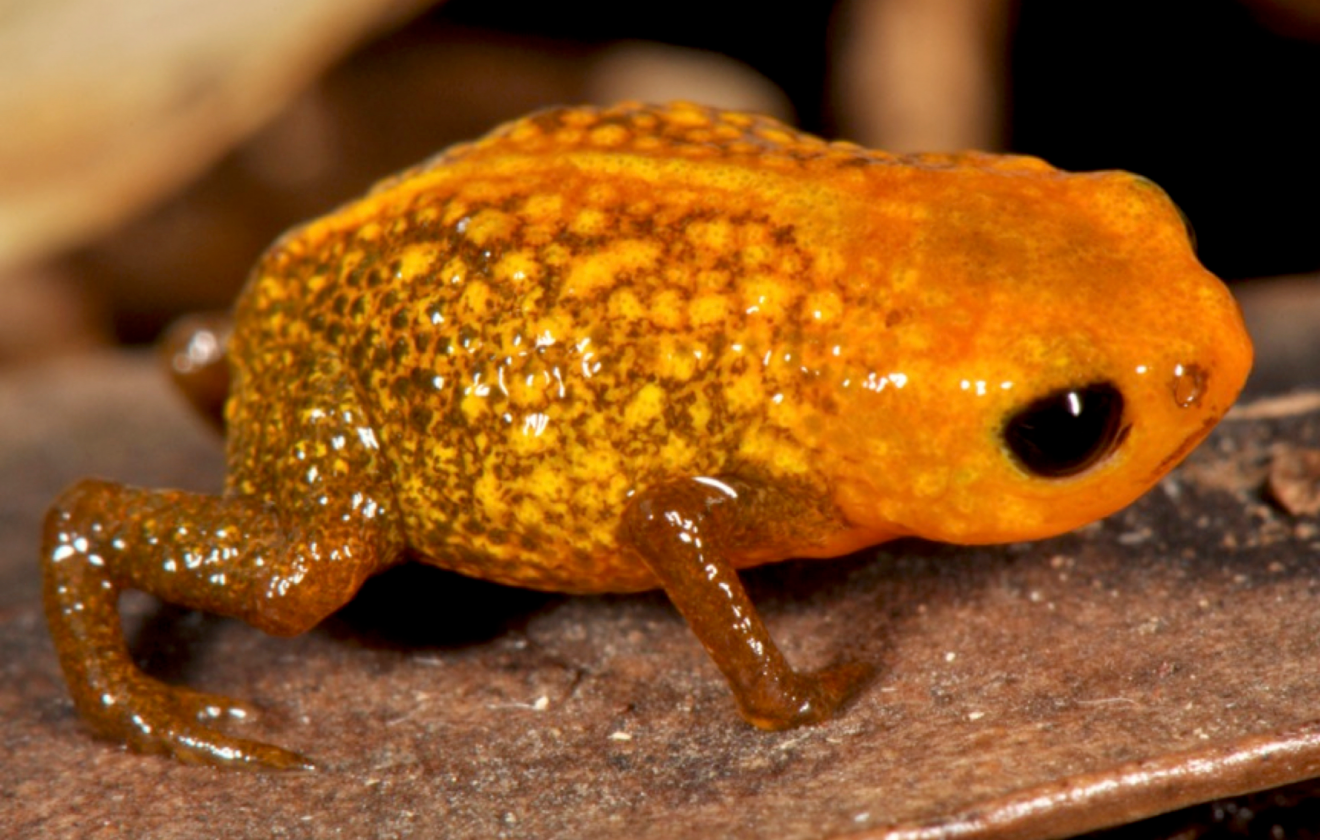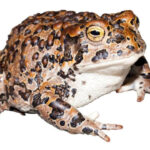- Brachycephalus auroguttatus: The Golden-speckled Jewel of Brazil's Atlantic Forest
- Taxonomy and Classification
- Natural Habitat: The Misty Depths of Brazil’s Atlantic Forest
- Physical Characteristics: A Tiny Masterpiece of Evolutionary Adaptation
- Behavior and Life Cycle: Secretive Lives Among Moss and Leaf Litter
- Ecological Role: Links in the Atlantic Forest Web
- Threats and Conservation: A Battle for Survival
- Cultural and Scientific Significance: Tiny Frog, Big Impact
- Conclusion: The Jewel Worth Saving
Brachycephalus auroguttatus: The Golden-speckled Jewel of Brazil’s Atlantic Forest#
Deep within the lush ecosystems of Brazil’s Atlantic Forest—a veritable paradise for biodiversity—lives a tiny, jewel-like frog whose existence captures the essence of nature’s delicate balance. Meet the Brachycephalus auroguttatus, a diminutive amphibian known to science only since recent decades but already inspiring fascination and urgency among conservationists, researchers, and nature lovers alike. Named for its distinctive golden speckles decorating its tiny frame, Brachycephalus auroguttatus is more than just a marvel of evolution; it represents the intricate beauty and fragility of tropical ecosystems currently under threat.
Yet, despite its striking appearance, this species remains somewhat enigmatic, hidden in plain sight beneath layers of leaf litter and moss-covered logs, quietly going about its daily rhythms in one of the world’s most endangered habitats. Join us as we journey into the misty forests of Brazil to uncover the natural history, habits, and conservation plight of the extraordinary golden-speckled Brachycephalus auroguttatus.
Taxonomy and Classification#
The golden-speckled frog belongs to the diverse genus Brachycephalus, nestled within the family Brachycephalidae. First described scientifically as Brachycephalus auroguttatus in 2015, its discovery is a testament to how richly biodiverse—and understudied—our planet still is. Sitting within a genus known popularly as “pumpkin toadlets,” these frogs derive their colloquial name from their vibrant orange and yellow hues and astonishingly small size.
The genus name itself—Brachycephalus—means “short head,” fittingly describing the tiny proportions of these remarkable creatures. Closely related to other miniature species such as Brachycephalus ephippium and Brachycephalus pitanga, the golden-speckled frog exhibits slight but meaningful differences in anatomy, coloration, and habitat preference, justifying its unique status as an independent species.
Natural Habitat: The Misty Depths of Brazil’s Atlantic Forest#
Imagine wandering beneath a dense canopy of ancient trees, your boots sinking softly into a carpet of fallen leaves, as the air fills with the cool whispers of humidity. This precise setting—the subtropical high-altitude montane forest of Brazil’s southeastern Atlantic forest—is the exclusive domain of Brachycephalus auroguttatus. Confined to restricted areas at altitudes ranging roughly from 800 to 1,300 meters above sea level, the species has adapted perfectly to the moist, shaded environments provided by dense leaf litter and mossy ground cover.
The particular microclimates formed by misty mountainsides, where sunlight filters gently through tangled branches above, provide precisely the stable humidity and temperature conditions required by these sensitive amphibians. The very limited geographic range—specifically to certain isolated mountain sites in the states of Paraná and São Paulo—renders Brachycephalus auroguttatus vulnerable to even subtle environmental disturbances.
The reliance of this tiny frog on such specific conditions highlights its role as an important indicator species. Changes—be it deforestation, climate shifts, or habitat degradation—impact these frogs significantly, thereby acting as clear signals of broader ecological imbalance.
Physical Characteristics: A Tiny Masterpiece of Evolutionary Adaptation#
Brachycephalus auroguttatus is remarkable not only for its alluring appearance but also for its miniaturization, a compelling evolutionary response to the myriad challenges faced by tropical amphibians. Adult individuals measure a mere 9-15 millimeters, easily fitting atop a human fingertip. Its robust but miniature build, complete with shortened limbs and compact body, is indicative of evolutionary specialization.
Yet despite their diminutive stature, it’s their vibrant appearance that captivates observers. The species displays an arresting orange hue, speckled delicately with luminous golden-yellow dots scattered across its dorsal area—the inspiration for its epithet “auroguttatus,” meaning “marked with gold.” Scientists believe that the bright coloration serves as an aposematic warning, signaling potential predators of the small amphibian’s hidden toxicity.
Indeed, like several other members of its genus, the golden-speckled frog possesses toxins in its skin glands—not potent enough to threaten humans, but adequate to discourage predators seeking an easy meal. These chemical defenses are complemented by subtle yet effective skin texture variations that enhance camouflage amidst leaf litter, a fascinating contradiction of visibility and concealment.
Behavior and Life Cycle: Secretive Lives Among Moss and Leaf Litter#
A Day in the Life: Cryptic Habits#
To catch a glimpse of Brachycephalus auroguttatus is a rare event, not just because of their scarcity, but due to their extremely cryptic and secretive lifestyle. Mostly active during the humid daylight hours, these frogs move cautiously through their damp habitats, preferring hidden crevices beneath logs, within moss patches, and deep among fallen leaves.
Their diet predominantly consists of tiny arthropods—mites, springtails, and minute insects—that thrive in the humid leaf litter of their habitat. Possessing keen eyesight adapted to detect subtle movements rather than elaborate details, they deftly capture prey with quick, deliberate lunges.
Reproduction: Voices of the Forest Floor#
Breeding behavior remains a partially mysterious aspect of their lives, though researchers have documented males issuing soft, buzzing courtship vocalizations during rainy periods to attract females. Unlike typical frogs, members of the genus Brachycephalus exhibit remarkable nesting behaviors, laying eggs directly into moist leaf litter or tucked carefully within terrestrial moss pockets rather than depositing them into standing water.
Remarkably, Brachycephalus auroguttatus bypasses aquatic tadpole stages entirely, exhibiting direct development where tiny frogs emerge fully formed from gelatinous eggs awaiting among the moist forest debris. This reproductive adaptation shields eggs and juveniles from many aquatic-based predators, allowing young frogs to immediately begin their life as miniature replicas of their parents.
Ecological Role: Links in the Atlantic Forest Web#
Brachycephalus auroguttatus, though small and elusive, plays a vital ecological role, contributing significantly to energy transfer within the forest’s intricate food webs. Acting as both predator and prey, these frogs regulate insect populations, performing crucial pest control services purely by their dietary habits. Simultaneously, they themselves become prey to various predators such as spiders, birds, or small mammals adapted to circumvent their chemical defenses.
Moreover, the species’ sensitivity to environmental fluctuations makes it invaluable to ecologists as a bioindicator. The presence or absence of this charming little frog communicates much about the health and stability of the Atlantic forest ecosystem itself.
Threats and Conservation: A Battle for Survival#
As human influence encroaches ever more deeply into pristine forests, the golden-speckled frog faces significant existential threats. Deforestation for logging, agriculture expansion, and urban development fragments and shrinks their already limited habitats. Adding urgency, climate change threatens to alter moisture and temperature patterns essential for their sensitive skin and reproductive cycles, potentially pushing this specialized species over the brink.
Although not yet formally assessed by the International Union for Conservation of Nature (IUCN), regional researchers express serious concerns. Protective measures such as protected area management, reforestation, and community ecological education are considered crucial in efforts to preserve the species’ habitat integrity.
Cultural and Scientific Significance: Tiny Frog, Big Impact#
Though tiny, the discovery and documentations of species like Brachycephalus auroguttatus hold immense scientific value, enhancing our understanding of evolutionary adaptations, ecotoxicology, and biodiversity hotspots conservation. Furthermore, locally, the golden-hued frog has begun to symbolize the magic, mystery, and vulnerability of Brazil’s once extensive, now depleted Atlantic Forest, a powerful emblem for conservation campaigns.
Conclusion: The Jewel Worth Saving#
From their extraordinary colors and intriguing behaviors to their ecological importance and pressing conservation vulnerabilities, Brachycephalus auroguttatus serves as a powerful reminder of the urgent necessity to protect Earth’s smallest and most miraculous inhabitants. By raising awareness and supporting conservation efforts, we each contribute to protecting the delicate threads of biodiversity, safeguarding not just one charismatic species but entire ecosystems and, ultimately, ourselves.
Let us treasure and protect the golden-speckled jewel glistening modestly within Brazil’s endangered forests, ensuring its delicate song continues amid fragrant mosses, under the quiet canopy forever.










